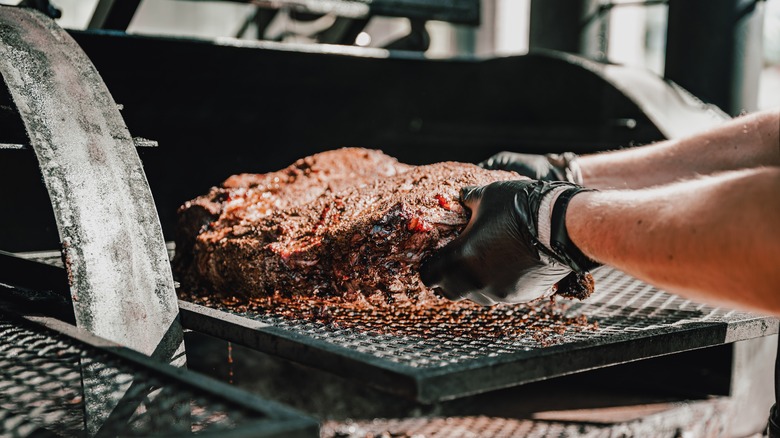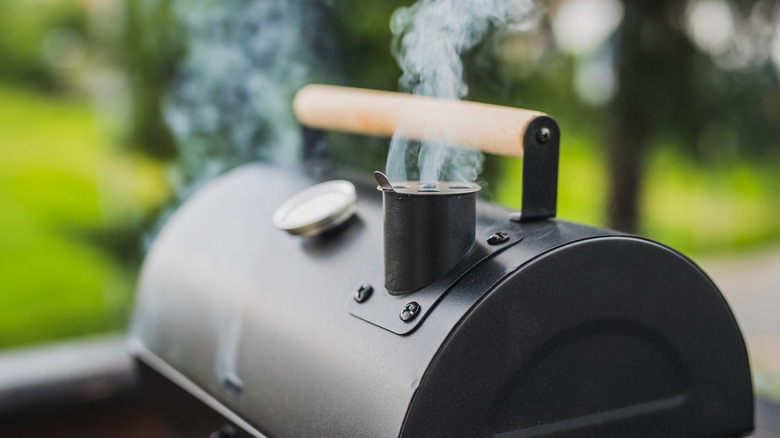The Difference Between Hot-Smoking And Cold-Smoking, Explained
Smoking is an ancient cooking technique making a resurgence in recent years. From smoked brisket at a backyard barbecue to smoked Gouda behind the deli counter at the grocery store, to a smoked old fashioned on the menu at a fancy cocktail bar, it is safe to say smoking is hot right now.
Exposing food to smoke from smoldering wood chunks or chips can have a variety of different effects on food. It can cook your food, flavor it, tenderize it, and it can preserve it. Depending on the desired outcomes, there are generally two methods for smoking meat, fish, vegetables, and other foods: cold smoking and hot smoking.
Hot smoking is typically used to cook meat and other food while adding flavor to the smoke. Cold smoking, on the other hand, is typically used to preserve food and extend its shelf life. So how exactly does each process work?
The hot-smoking process
The hot-smoking technique involves cooking food with smoldering wood and smoke to add complex flavors to meats, seafood, and more, usually at a temperature ranging from 190 degrees Fahrenheit to 300 degrees Fahrenheit. There are smokers designed specifically for this cooking method, but cooks can also hot smoke using a gas grill, a charcoal grill, or even a wok.
Smoking usually involves smoldering wood chips or chunks so that they give off smoke instead of catching fire. Depending on the cooking mechanism, the wood may be kept in a smoker box or chamber, or be distributed directly on the grill's coals. Different types of wood burn differently and give off different flavors, but common woods for smoking include mesquite, hickory, maple, oak, walnut, apple, cherry, and cedar.
Known as a "low and slow" method, hot smoking usually takes several hours, since meats and other foods typically soften with longer cooking times and lower temps. Some barbecue restaurants even brag about how long their meats are smoked, advertising 10-hour smoked brisket or 12-hour smoked pork on their menus.
The cold-smoking process
Used mainly as a preservation process rather than a cooking method, cold smoking typically involves curing meat, seafood, or vegetables to extract moisture and prevent bacterial growth, then exposing the food to smoke for flavor and preservation. Smoked salmon and meats like salami are some of the most common foods that are cold-smoked.
As you would imagine, cold smoking occurs at a much lower temperature than hot smoking. Because of this, it has a lot more health risks than hot smoking. Smoking usually occurs at around 90 degrees Fahrenheit, which is within the range of temperatures known as the "danger zone" for food — between 40 degrees Fahrenheit and 140 degrees Fahrenheit — where bacteria grow most rapidly. This is why the curing process is crucial to cold smoking. Curing meats, fish, and other foods by salting or brining draws out moisture and inhibits bacterial growth.
Once the food has been cured, it needs to be exposed to smoke without too much heat. Usually, this involves placing the food in a chamber or box into which smoke is pumped usually for around 12 to 48 hours, depending on the food. A designated smoker is typically the easiest way to achieve this, but there are some DIY methods to cold smoke as well. If you want to try out cold smoking, check out our recipe for Cold-Smoked Fried Chicken.


